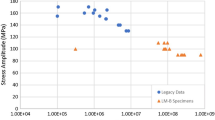Abstract
A metallograph was mounted directly on a closed-loop electrohydraulic testing unit and initiation of fatigue cracks was directly observed on polished notches at magnifications up to 800 times in aluminum alloys 2024 and 2124 in the T-4 condition. The latter is a high purity version of 2024 and contains considerably fewer constituent particles. At high stresses on the notch surface the fatigue cracks initiated on coarse slip lines in both alloys. At low stresses almost all of the cracks in 2024 initiated in the matrix adjacent to constituent particles. In 2124 at low stresses 50 pct of the cracks initiated near constituent particles and 50 pct in the matrix not near constituent particles. The probability that a constituent particle in 2024 initiates a fatigue crack falls off very rapidly as the particle size decreases below 6 μm. Growth of microcracks is impeded by grain boundaries.
Similar content being viewed by others
References
M. S. Hunter and W. G. Fricke:Proc. ASTM, 1954, vol. 54, p. 717.
J. C. Grosskreutz and G. G. Shaw:Proc. of 2nd Int. Conf. on Fracture, P. L. Pratt, ed., pp. 620–29, Chapman and Hall, London 1969.
R. E. Peterson:Metal Fatigue, G. Sines and J. L. Waisman, eds., Chap. 13, McGraw-Hill, NY, 1959.
Y. Kung: Ph.D. Dissertation, Northwestern University, Evanston, Ill., 1978.
P. J. E. Forsyth:J. Inst. Metals, 1951–52, vol. 80, p. 181:ibid., 1953–54, vol. 82, p. 449; Nature, Lond., 1953, vol. 171, p. 172; Int. Conf. on Fatigue, Institution of Mechanical Engineers, 1956, p. 135; Phil. Mag., 1957, vol. 2, p. 437; Proc. Roy. Soc, 1957, vol. A242, p. 198; P. J. E. Forsyth and A. Stubbington: Nature, Lond., 1955, vol. 175, p. 767; J. Inst. Metals, 1954-55, vol. 83, p. 173; ibid., 1954-55, vol. 83, p. 395; ibid., 1956–57, vol. 85, p. 339; A. Stubbington and P. J. E. Forsyth: J. Inst. Metals, 1957–58, vol. 86, p. 90.
Laird and D. J. Duquette: NACE-2, pp. 88–117, University of Connecticut, Storrs, Conn., 1972.
G. R. Irwin:Trans. ASME, Scr. E. J. Appl. Mech., 1962, vol. 29, pp. 651–654.
W. F. Brown, and J. E. Strawley: ASTM STP 410, 1967.
W. L. Morris:Met. Trans. A, 1977, vol. 8A,p. 1079; ibid.,p. 1087; ibid., p. 589; W. L. Morris and O. Buck, ibid., p. 597; W. L. Morris, O. Buck and H.L.Marcus: Met. Trans. A, 1976,vol. 7A,p. 1161.
T. Yokobori, M. Uozumi and M. Ichikawa: Reports of the Research Institute for Strength and Fracture of Materials, 1971, vol. 7, No. l,p.25;A. Kamei and T. Yokobori: ibid., 1974, vol. 10, No. 2, p. 45.
Author information
Authors and Affiliations
Additional information
This research was done at Northwestern University.
Rights and permissions
About this article
Cite this article
Kung, C.Y., Fine, M.E. Fatigue Crack initiation and microcrack growth in 2024-T4 and 2124-T4 aluminum alloys. Metall Trans A 10, 603–610 (1979). https://doi.org/10.1007/BF02658324
Received:
Issue Date:
DOI: https://doi.org/10.1007/BF02658324




